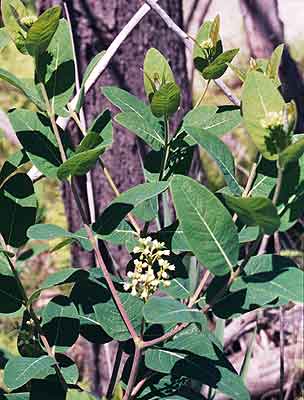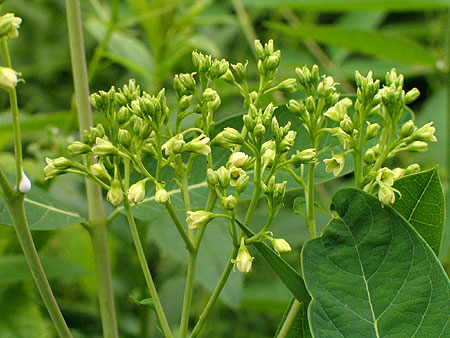Damp areas produce the tallest, thickest plants; those on the sidehills are bushier and not as good. The harvested plants were bundled by the lower ends for carrying. The branches and leaves were cleaned off, and the stems were flattened by pulling them over a pole tied to a tree. They were then split open from bottom to top with a sharp stick. The woody, outer skin was pulled off by hand after rubbing the stems. The the fibrous parts just under the skin were bundled together and hung by the tops in the wind to dry. When dry they were brittle. The process of rubbing the hemp helps to separate the fibers. The fibers were made into twine by twisting and rolling them with the hand on the bare thigh. The hands were kept damp to increase the friction. The stem fibers were joined together by splicing; the thick (lower) end of one fiber bundle and the thin (upper) end of another were each split about one half of the length of the stem, and the pieces placed together as an interlocking "V", then rolled together until they were intertwined. An average plant yields about 2-1/2 feet of fiber, but half of this is lost in the splicing process. By splicing the stems together, a continuous length of twine could be produced. A finer twine was made by splitting the stems in two along the entire length and using the halves as one would a whole stem. A strong rope could be made by twisting several lengths of twine together. A good Indian hemp rope is said to have the equivalent strength of a modern hemp rope with a breaking point of several hundred pounds. The twine would keep for many years if stored in a dry place.

Perennial herb with stems ascending to erect. Leaves opposite, with petiole < 5-8 cm blade. Flower small; corolla cylindric to urn-shaped, 5-lobed, with 5 triangular appendages alternate with the stamens; stamens attached at base of tube, filaments short, wide, anthers forming adherent cone around stigma, each partly steile, sharply arrow-shaped; nectaries 5, around the ovaries; style none; stigma massive. Fruit slender, cylindric, pointed follicle generally greater than 12 cm. Seed with tuft of long hairs. Fragrant flowers in bloom from May to July due to the successive development of new clusters. Bees produce a very fine grade of honey from these. The seed pod (follicle) is an amazing affair being shaped like a smooth, curved green bean. This brownish husk splits open to allow silky seeds to escape. A thick milky juice exudes from any broken portion of the plant, and might be considered poisonous.
 Indian Hemp
Indian Hemp